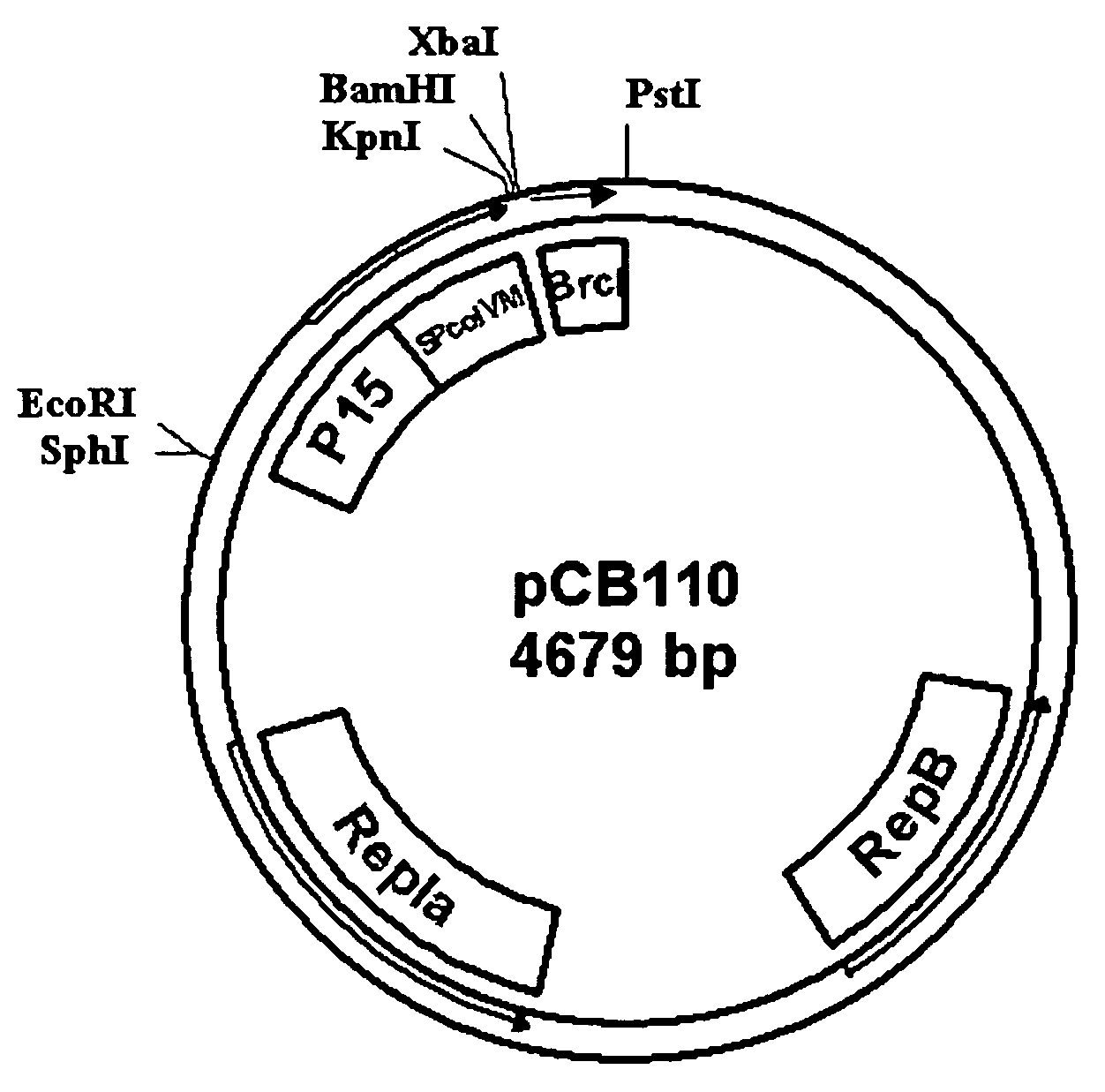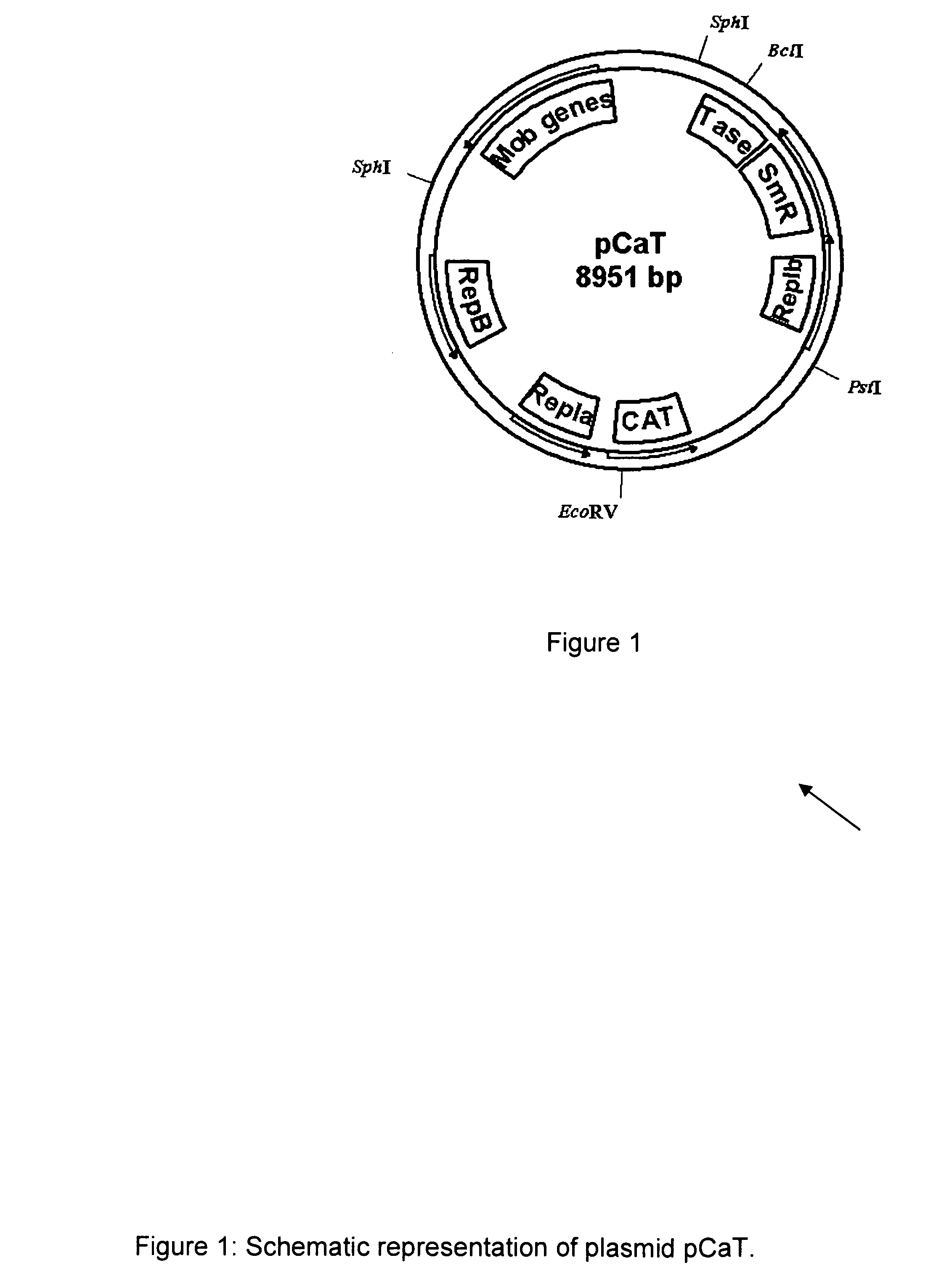Expression vectors for treating bacterial infections
a technology of expression vectors and bacteria, applied in the field of expression vectors, can solve the problem of not being “targeted” against specific pathogens
- Summary
- Abstract
- Description
- Claims
- Application Information
AI Technical Summary
Benefits of technology
Problems solved by technology
Method used
Image
Examples
example 1
Use of Plasmid pCaT and its Derivatives as Cloning Vectors in LAB
[0074]FIG. 1 shows a schematic representation of plasmid pCaT from Lactobacillus plantarum caTC2R (Jewell and Collins-Thompson, 1989). The pCaT plasmid was reported to contain the genetic information for chloramphenicol resistance (cat gene). The inventors have fully sequenced and partially characterized the plasmid. The plasmid has been transformed into various Carnobacterium spp., L. plantarum NC8 and L. casei ATCC 393, demonstrating chloramphenicol resistance in these strains (Ahn et al., 1992). The pCaT plasmid contains 8951 base pairs. Several putative genes were located, including genes involved in replication (repB, repIa and repIb), mobilization (mob), antibiotic resistance for chloramphenicol (cat) and streptomycin (str), and a truncated open reading frame that could encode a transposase (Tase) (See FIG. 1). The inventors have used pCaT as a cloning vector for genes related to the production of proteins such...
example 2
Introduction of Bacteriocin Immunity Genes as Selection Markers into Colicin V Producing pCaT Derivatives Transformed into LAB
[0076] Immunity genes for bacteriocins were introduced into pCV22 as genetic selection markers. Two different functional polynucleotide sequences encoding bacteriocin immunity proteins were selected for this procedure: carnobacteriocin A immunity gene and brochocin-C immunity gene (Franz et al., 2000; McCormick et al., 1998). In plasmid pCF08 the mid-sequence encoding carnobacteriocin A immunity was cloned behind the P32 promoter (functional) (Franz et al., 2000). A 28-mer oligonucleotide (5′-TAT ATG ATC AGG TCC TCG GGA TAT GAT A-3′) (Seq. I.D. No. 8) containing a Bc / I restriction site (underlined) was added to a sequence homologous to the 5′ end of the nucleotide sequence containing the P32 promoter in pCF08 (Franz et al., 2000) and a 28-mer oligonucleotide (5′-TAT ACT GCA GGG TAC CGT CTA CAG TCT G-3′) (Seq. I.D. No. 9) containing a PstI restriction site (...
example 3
Isolation and Selection of Lactobacillus reuteri CB4 for use as a Host to Develop a Targeted Probiotic Organism
[0077] The gastrointestinal tract (GIT) of two healthy pigs was obtained from a small, provincially inspected meat packing plant at time of slaughter. The GIT was excised, sealed at the anterior and posterior ends and transported to the Animal Science laboratory at the University of Alberta Research Station (Edmonton, Canada). The GIT was flushed with tap water to remove the intestinal contents and segments were excised from the pars esophagea, ileum, jejunum, cecum and colon. The internal surface of the excised segments was scraped with a sterile microscope slide to remove the surface of the epithelial layer.
[0078] The scrapings were washed into a dilution bottle, plated onto Difco Lactobacilli MRS agar (MRS) and incubated anaerobically at 37° C. for 18 to 24 hours. A total of 18 morphologically distinct colonies was randomly selected and checked for Gram-positive, cata...
PUM
| Property | Measurement | Unit |
|---|---|---|
| concentrations | aaaaa | aaaaa |
| concentrations | aaaaa | aaaaa |
| antibiotic resistance | aaaaa | aaaaa |
Abstract
Description
Claims
Application Information
 Login to View More
Login to View More - R&D
- Intellectual Property
- Life Sciences
- Materials
- Tech Scout
- Unparalleled Data Quality
- Higher Quality Content
- 60% Fewer Hallucinations
Browse by: Latest US Patents, China's latest patents, Technical Efficacy Thesaurus, Application Domain, Technology Topic, Popular Technical Reports.
© 2025 PatSnap. All rights reserved.Legal|Privacy policy|Modern Slavery Act Transparency Statement|Sitemap|About US| Contact US: help@patsnap.com



